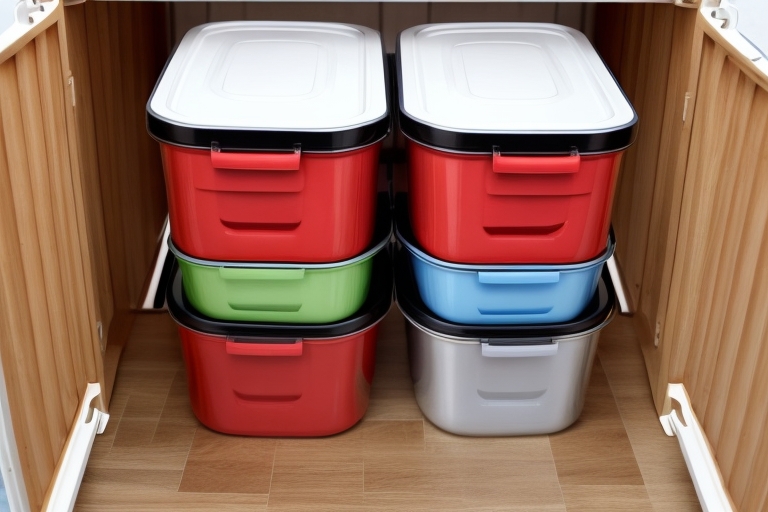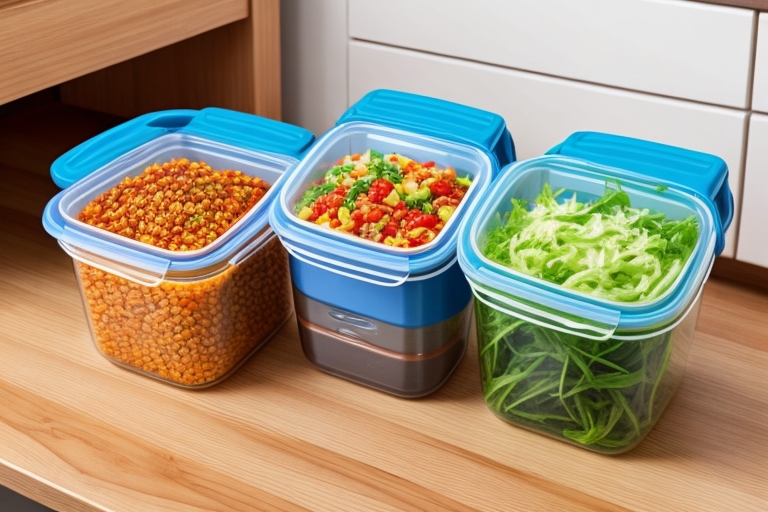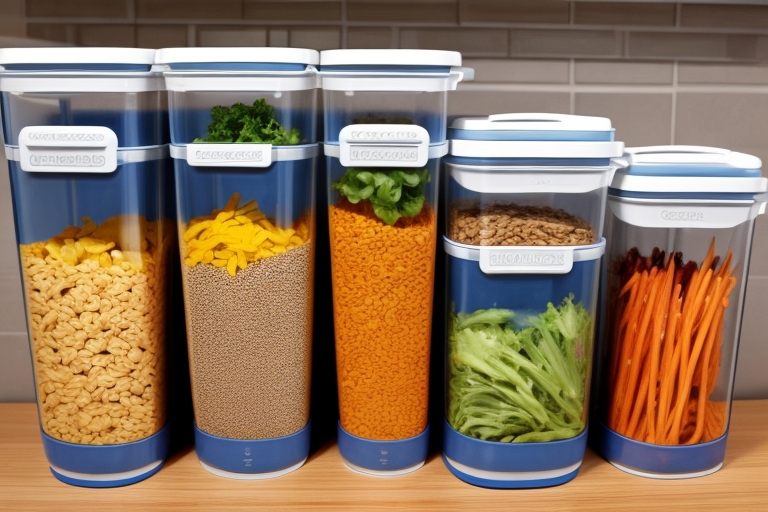
The number of food storage containers you need will depend on various factors, such as your household size, meal habits, and frequency of cooking. Here are some general guidelines to help you determine the number of food storage containers you need:
- Small containers: A set of 8-12 small containers can be used for storing leftovers, taking food on the go, or storing small snacks.
- Medium containers: A set of 4-6 medium containers can be used for storing larger portions of leftovers, or for packing a lunch for work or school.
- Large containers: A set of 2-3 large containers can be used for storing bulk items, such as soups, stews, or large portions of casseroles.
- Specialty containers: Consider purchasing specialty containers for items like salad, sandwiches, or snacks, such as bento boxes or reusable snack bags.
Remember, you don’t need to purchase a full set of containers at once. You can start with a few and add more as needed. Additionally, consider the size of your refrigerator and cabinets when selecting your food storage containers to ensure that they fit and are easy to store.
In this article, we’ll discuss how many food storage containers you need to keep your food safe and organized. We’ll provide helpful tips and tricks to make sure you have the right number of containers for your needs. With our friendly advice, you’ll be able to make the most of your food storage and keep your kitchen neat and tidy. So, let’s get started!
Types of Food Storage Containers
There is a wide variety of food storage containers available, each designed for specific purposes. Here are some common types:
- Plastic Containers:
- Advantages: Lightweight, durable, and often inexpensive. Available in various sizes and shapes.
- Considerations: Choose BPA-free options for health safety. Some may stain or absorb odors over time.
- Glass Containers:
- Advantages: Durable, resistant to staining and odors, and suitable for reheating in the microwave or baking in the oven.
- Considerations: Heavier than plastic and can break. Lids may have plastic components.
- Airtight Containers:
- Advantages: Designed to keep air out, maintaining the freshness of dry goods like flour, rice, and cereals.
- Considerations: Check the quality of the seal to ensure airtightness.
- Mason Jars:
- Advantages: Versatile for both dry and wet storage. Great for canning and preserving.
- Considerations: Lids may need to be replaced over time.
- Vacuum-Sealed Containers:
- Advantages: Remove air to prolong the freshness of stored food, especially for perishables.
- Considerations: Some require specialized equipment for sealing.
- Stainless Steel Containers:
- Advantages: Durable, resistant to rust and staining, and free from chemicals found in some plastics.
- Considerations: Can be heavier and may not be suitable for microwaving.
- Silicone Storage Bags:
- Advantages: Reusable, eco-friendly, and suitable for both dry and wet storage.
- Considerations: Check for food-grade silicone. May not stand upright without support.
- Collapsible Containers:
- Advantages: Save space when not in use. Ideal for those with limited storage space.
- Considerations: May not be as durable as rigid containers.
- Bento Boxes:
- Advantages: Compartmentalized containers, great for portion control and packing lunches.
- Considerations: Check for leak-proof options if used for liquids.
- Produce Storage Containers:
- Advantages: Designed to extend the freshness of fruits and vegetables.
- Considerations: Choose breathable containers for certain produce.
- Disposable Containers:
- Advantages: Convenient for meal prep, picnics, or leftovers.
- Considerations: Not environmentally friendly. Choose biodegradable options if possible.
- Specialized Containers (E.g., Egg Holders, Cheese Keepers):
- Advantages: Tailored for specific food items, helping to preserve their freshness.
- Considerations: Consider whether these specialized containers suit your needs.
When selecting food storage containers, it’s important to consider the type of food you plan to store, your storage space, and your preferences for materials and sustainability. Mixing and matching different types based on your needs can lead to a well-rounded food storage collection.
Assessing your storage needs

Assessing your storage needs before diving into the world of food storage containers is a crucial step to avoid ending up with a mishmash of mismatched containers cluttering your kitchen. Let’s break down why it’s important and what factors to consider:
Importance of Assessing Storage Needs:
- Efficiency: Assessing your needs ensures you get containers that fit your lifestyle, making it easier to organize and locate items.
- Prevention of Waste: Choosing the right sizes and types helps prevent food wastage by keeping items fresh and in the right quantities.
- Space Optimization: Proper assessment prevents over-purchasing or underestimating, optimizing your kitchen storage space.
Factors to Consider:
- Household Size: A larger household will naturally require more storage space. Consider the number of family members when deciding on container quantities.
- Cooking Habits: If you enjoy meal prepping or cooking in batches, you’ll need containers that accommodate larger portions.
- Frequency of Use: Containers for frequently used items should be easily accessible. Reserve prime space for these essentials.
- Types of Food Stored: Different foods have varying storage requirements. Consider whether you need airtight containers, stackable ones, or those suitable for the freezer.
Determining Container Needs:
- Quantifying Usage: Assessing factors like household size and cooking habits helps you estimate the volume of food storage required.
- Categorizing Food: Group similar items together to determine the types of containers needed. Dry goods may require different containers than perishable items.
- Prioritizing Accessibility: Place frequently used items in easily reachable containers to streamline your daily cooking routine.
- Considering Future Needs: Anticipate changes in your household or lifestyle to avoid outgrowing your storage solutions too quickly.
By considering these factors, you’ll be better equipped to choose the right containers in terms of size, type, and quantity. It’s a bit like a puzzle – fitting the pieces of your storage needs together for a well-organized and efficient kitchen.
Categorizing your storage containers
Categorizing your food storage containers is like creating an organized harmony in your kitchen. Let’s dive into the benefits and different categories, along with some tips on efficient organization:
Benefits of Categorizing:
- Easy Accessibility: Categorization allows you to quickly locate the right container for your needs, saving time and effort.
- Space Optimization: Grouping containers by size and purpose helps in efficiently using your storage space, avoiding clutter.
- Preventing Mismatch: Knowing where each type and size of container belongs minimizes the chances of grabbing the wrong one and messing up your organization.
Different Categories:
- Small Containers (e.g., for sauces and dressings):
- Benefits: Perfect for preserving smaller quantities, avoiding waste, and keeping condiments organized.
- Tip: Stack these in a designated section for easy access.
- Medium-Sized Containers (e.g., for leftovers):
- Benefits: Ideal for storing daily meal leftovers or prepped ingredients.
- Tip: Nest these containers to save space, and label them with the date for quick identification.
- Large Containers (e.g., for bulk food storage):
- Benefits: Great for storing bulk purchases, like grains, pasta, or snacks.
- Tip: Opt for stackable containers to make the most of vertical space in your pantry.
Efficient Organization Tips:
- Use Clear Containers: Opt for transparent containers to easily see the contents without opening them, reducing guesswork.
- Invest in Modular Containers: Containers with similar shapes and sizes are easier to stack and organize.
- Drawer Dividers or Bins: If you have a drawer designated for storage containers, use dividers or bins to separate different categories.
- Lid Organization: Store lids separately or use lid organizers to avoid a chaotic jumble of mismatched lids.
- Rotate Stock: Periodically check and rotate your stock to ensure older items get used first, preventing food waste.
Efficiently categorizing and organizing your storage containers isn’t just about aesthetics; it’s about creating a functional system that enhances your kitchen experience. Plus, it makes those moments of searching for the right container a thing of the past!
Determining the quantity needed

Determining the quantity of food storage containers needed can be a bit of trial and error, but here are some practical guidelines and recommendations:
1. Start Small, Assess, and Adjust:
- Begin with a basic set of containers for each category—small, medium, and large.
- Assess your usage patterns over a few weeks to understand how many containers you actually need for each category.
2. Small Containers (e.g., for sauces and dressings):
- Start with 4-6 small containers per person in the household.
- Adjust based on your frequency of using condiments and sauces.
3. Medium-Sized Containers (e.g., for leftovers):
- Begin with 5-7 medium containers per person.
- Adjust based on your cooking habits; if you frequently cook in batches, you might need more.
4. Large Containers (e.g., for bulk food storage):
- Aim for 3-5 large containers for bulk items per person.
- Adjust based on the storage space available and how often you buy in bulk.
5. Consider Household Size:
- For a family of four, start with quantities mentioned above multiplied by the number of family members.
- Adjust based on individual preferences and the frequency of grocery shopping.
6. Occasional Extras:
- Include a couple of extra containers in each category for unexpected needs or when you host gatherings.
Examples:
- A couple might start with 4 small, 5 medium, and 3 large containers each.
- A family of four could begin with 16 small, 20 medium, and 12 large containers.
Recommendations:
- If you find yourself frequently running out of a specific size, consider increasing the quantity gradually.
- Pay attention to the types of meals you prepare; if you often cook complex dishes requiring multiple ingredients, you might need more containers.
Remember, these are general guidelines, and your actual needs may vary based on your lifestyle, cooking habits, and available storage space. Starting with a modest set and adjusting as needed is a practical approach to avoid clutter and ensure you have the right containers for your specific requirements.
Maintaining and decluttering
Maintaining and decluttering your food storage containers is the key to a functional and stress-free kitchen. Here’s why it’s crucial and some tips to keep things in order:
Importance of Regular Maintenance:
- Hygiene: Regular cleaning prevents the growth of bacteria and ensures the containers are safe for storing food.
- Efficiency: Decluttering helps you find the right container quickly, saving time during meal preparation.
- Odor Prevention: Proper maintenance prevents lingering odors from impacting the flavor of your stored food.
Tips for Cleanliness and Organization:
- Regular Cleaning: Wash containers after each use with warm, soapy water to maintain cleanliness.
- Deep Cleaning: Periodically remove and clean the gaskets or seals of airtight containers to prevent odors.
- Drying Completely: Ensure containers are completely dry before storing them to prevent mold growth.
- Organize Lids: Store lids separately or use lid organizers to avoid a chaotic jumble.
- Rotate Stock: Periodically assess your containers and discard any that are damaged or no longer functional.
Preventing Odors:
- Baking Soda: Place an open box of baking soda in your storage area to absorb odors.
- Coffee Grounds: Unused coffee grounds can also help neutralize odors; place them in a breathable bag in the storage space.
Repurposing or Recycling Unneeded Containers:
- Donate: If your containers are in good condition, consider donating them to local charities, schools, or community centers.
- Gardening: Use larger containers for gardening or planting small herbs. Drill holes in the bottom for drainage.
- Craft Storage: Small containers can be repurposed for storing craft supplies like buttons, beads, or paint.
- Recycle: If containers are damaged or can’t be repurposed, recycle them according to your local recycling guidelines.
Regular Assessment:
- Every Few Months: Take a few minutes every few months to assess your container collection.
- Discard Damaged Ones: If a container is cracked, stained, or has a damaged seal, it’s time to let it go.
Maintaining and decluttering your food storage containers is an ongoing process that ensures your kitchen remains organized, clean, and efficient. It not only benefits your daily cooking routine but also contributes to a more sustainable and mindful approach to household items.
Tips for Storing Food in Containers Safely and Efficiently
Once you have the right type of food storage containers, it’s important to store your food safely and efficiently. Here are some tips to help you do just that:
- Label your containers clearly – Ensure each container is labeled clearly with the name of the food contained within and the expiration date. This will help you quickly identify what is inside and when it needs to be eaten or thrown away.
- Keep lids on tight – Make sure all lids are tightly secured onto the containers to avoid leaks or spills. You can also use rubber bands, tape, or stretch wrap for extra insurance.
- Stack smartly – Place heavier items on the bottom and lighter items on top when stacking your containers in the refrigerator or cupboard. This will help prevent larger, heavier items from crushing smaller ones underneath them.
- Use air-tight sealing – Opt for air-tight sealing containers which form an impenetrable seal around the edges of your food storage containers to keep out moisture. This will keep your foods fresher for longer periods of time and prevent spoilage or freezer burn.
- Clean regularly – Clean your food storage containers regularly and thoroughly with warm, soapy water (or in a dishwasher). Food residue left behind can attract pests, contaminate other foods, or create an unappetizing odor in your kitchen.
FAQs
- How do I determine the right quantity of food storage containers for my needs?
- Consider the number of meals you plan to prepare in advance and the storage capacity of each container.
- What sizes of food storage containers should I have in my kitchen?
- It’s advisable to have a variety of sizes to accommodate different portions. Small containers for snacks, medium for individual meals, and larger ones for bulk storage.
- Is it better to have a uniform set of containers or a mix of different brands and types?
- It depends on your personal preferences and storage space. A uniform set can stack neatly, while a mix allows versatility in accommodating various food shapes and sizes.
- How many containers should I have for leftovers and meal prepping?
- Having enough containers to cover at least a week’s worth of meals can be convenient. Consider the number of times you plan to cook or prepare meals in a week.
- Should I invest in reusable or disposable containers for food storage?
- Reusable containers are environmentally friendly and cost-effective in the long run. However, disposable containers might be suitable for certain situations like transporting food or for one-time use events. Consider your lifestyle and preferences.

Pingback: Are Silicone Food Storage Containers Safe?